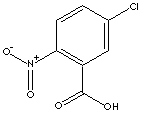Benzoic acid,
the simplest aromatic carboxylic acid containing carboxyl group bonded directly
to benzene ring, is a white, crystalline organic compound; melting at 122 C
(starting sublime at 100 C); boiling at 249 C; slightly soluble in water,
soluble in ethanol, very slightly soluble in benzene and acetone. Its aqua
solution is weakly acidic. It occurs naturally in many plants and resins.
Benzoic acid is also detected in animals. The most of commercial benzoic acid is
produced by the reaction of toluene with oxygen at temperatures around 200 C in
the liquid phase and in the presence of cobalt and manganese salts as catalysts.
It can be prepared also by the oxidation of benzene with concentrated sulphuric
acid or carbon dioxide in the presence of catalysts. Other methods are such as
by the oxidation of benzyl alcohol, benzaldehyde, cinnamic acid; by hydrolysis
of benzonitrile, benzoyl chloride. More than 90% of commercial benzoic acid is
converted directly to phenol and caprolactam. Its use in the production of
glycol benzoates for the application of plasticizer in adhesive formulations is
increasing. It is also used in the manufacture of alkyd resins and drilling mud
additive for crude oil recovery applications. It is used as a rubber
polymerization activators and retardants. Benzoic acid is converted to its salts
and esters for the use of preservative application in foods, drugs and personal
products. Sodium benzoate, sodium salt of benzoic acid, is used preferably as
one of the principal anti-microbial preservatives used in foods and beverages
(but it's concentration is limited usually not exceeding 0.1% because it is
poisonous), as it is about 200 times more soluble than benzoic acid. Sodium
Benzoate is also used in medications, anti-fermentation additives and tabletting
lubricant for pharmaceuticals. The industrial applications are as a corrosion
inhibitor, as an additive to automotive engine antifreeze coolants and in other
waterborne systems, as a nucleating agents for polyolefin, as a dye
intermediate, as a stabilizer in photographic processing and as a catalyst. Wide
range of benzoic esters are used as solvents, dying carrier, disinfectant
additive, penetrating agent and pesticides and manufacturing other compounds.
Nitro- is the
prefix indicating presence of the group -NO2. Historically They
are abundant in dyes and explosives. Nitro compounds, organic hydrocarbons
having one or more NO2 groups bonded via
nitrogen to the carbon framework, are versatile intermediate in organic
synthesis of;
- Michael
addition
- Reduction
- Henry
Reaction (Nitro-aldol reaction)
- Nef
reaction
- O-Alkylation
- Cycloaddition
- Substitution, Elimination, Conversion
reaction
- Alkylation,
Acylation, and Halogenation
Nitrobenzoic acid derivatives are used as an intermediate
functional dyes, pharmaceuticals and other chemical compounds. |
